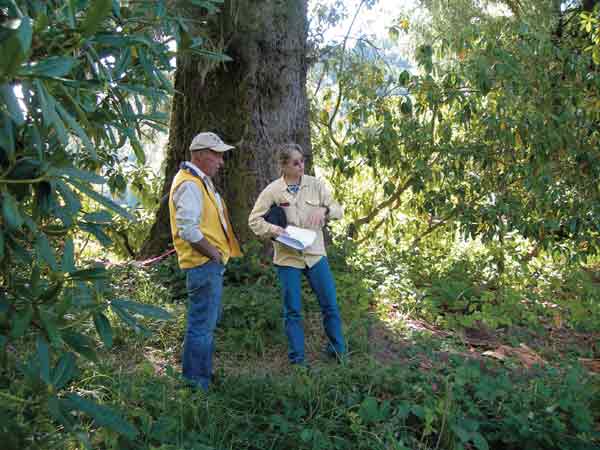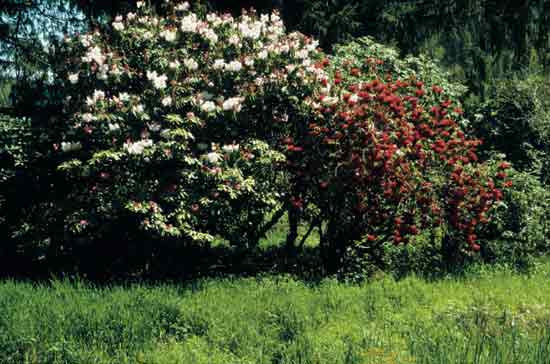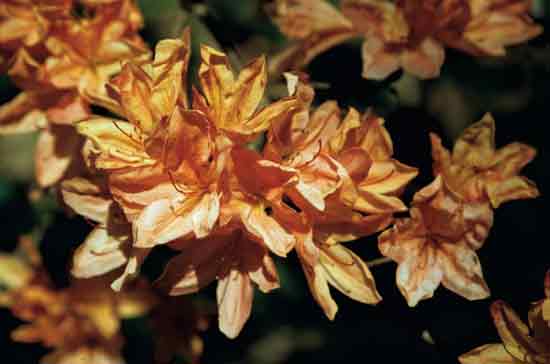Spruce Reach Island: The Oregon Coast's Secret Rhododendron Garden, Part III
The Hinsdale Estate, Dean Creek, Near Reedsport
John M. Hammond
Bury Lancashire
England
Gordon K. Wylie
Creswell, Oregon
Part I in the Fall 2007 issue laid the historical foundation for the Hinsdale Estate garden. Part II described the development of the garden. Part III in the Spring 2008 issue concludes the series with a report by Gordon Wylie on Garden Visits, Discussions, Progress and Future.
Garden Visits, Discussions, Progress and Future
One of the authors first saw this garden several years ago in the early summer of about 2000. Spearheaded by the Siuslaw Chapter, ARS, a group met at the Hinsdale property to explore the possibility of restorative work in the garden, which then appeared - though the bloom period was largely over - a fairly impressive plant collection. That project, however, languished because of the scope of work required, limited resources and modest interest by the Bureau of Land Management (BLM). At that time, vehicles could be driven to the main garden across a wooden bridge spanning the slough paralleling the highway. Flanked by mature trees and rhododendrons, a paved driveway ending in a circular turnaround and generous parking area led to the house and garden.
In the spring of 2003, following contact and arrangements we made with the BLM, both of us made an exploratory trip to see the garden in the company of BLM representative Bob Golden, Umpqua Park Ranger and Site Manager for Bureau holdings in the region. Those properties have the overall designation of "Dean Creek Elk Viewing Area," and include tracts both north and south of the highway encompassing a substantial area.
A good number of plants were in flower on this occasion, making it much easier than on the earlier visit to evaluate the nature of the plantings and the garden’s potential. The Bureau had recently cut back grass, blackberries and other undergrowth in anticipation of our visit, thus facilitating viewing individual plants. Unfortunately, not long before, highway workers had run heavy equipment onto the bridge leading to the house, resulting in breaking its supporting structure so that the only access possible was on foot. More of this later, but because the largest portion of the garden is an island surrounded on three sides by a slough rising and falling with the tides, with the fourth side defined by the Umpqua River, access for evaluation or any other work in the largest portion of the garden has been a major issue with the unsafe bridge.
At the time of that first joint visit we knew almost nothing about the garden’s creation or the Hinsdale family. As will be apparent from the first portions of this series, a fairly complete picture of the garden’s history has since emerged, along with some fascinating glimpses into pioneering business efforts to wrest entrepreneurial earnings from the area’s abundant natural resources.
Probably our primary initial reaction was to the size and maturity of the plant material, which is equal to or greater than the largest plants in the rhododendron gardens at Crystal Springs in Portland and Hendricks Park in Eugene. In addition to the rhododendrons, a significant collection of very large and thriving camellias surrounds the house, and a number of magnolias and other specimen trees revealed themselves among the plantings. On this visit a major clue to the rhododendrons’ origins came with identifying many as English hybrids grafted on
Rhododendron ponticum
rootstock, the latter betrayed by large suckers competing with the grafted hybrids. Though we could see a great number of sizable rhododendrons east of the house across the slough, that area was quite overgrown and inaccessible at the time of this first visit.
Our preliminary assessment was that the plantings were of historical significance and that despite plant loss over the years the substantial number remaining justified restoration efforts. In addition to the vigorous brambles and other undesirable undergrowth, and root stock suckers, the tree canopy was overgrown to the point of preventing sufficient light reaching the plants. But despite that and their having had no supplemental water in summer or other care beyond occasional grass and brush removal, the large number of rhododendrons, camellias and other companions appeared both well established and growing in conditions very much to their liking. As a result of these observations, we outlined remedial steps needed to prevent further deterioration in our conversations with Bob Golden. He was understandably cautious about any commitments, given limited funding levels and the Hinsdale property’s low priority among the many demands of other BLM responsibilities. We concluded our discussion by agreeing to forward our observations and recommendations in writing to the Umpqua Field Office of the BLM, and to further explore how the garden had come to exist at this location.
Research into the garden’s history and correspondence with the BLM office continued during the next couple of years, and in late 2004 we were advised many of the remedial steps recommended had been accomplished. A second joint visit was scheduled for the spring of 2005, and on a very wet day in early May we met Bob Golden and his supervisor, Kathy Wall, at the garden. The bridge’s condition had further deteriorated, and we were thus confined to the area east of the slough across from the house. A substantial amount of clearing had by then been accomplished in that area, allowing close examination of those rhododendrons. The main part of the garden on the island was surveyed with the aid of binoculars, where it was apparent the same substantial effort in clearing had taken place, and some start made on raising the tree canopy. Plus we saw no sign of the numerous
R. ponticum
suckers so prevalent two years earlier. Plants were responding with a wealth of flowers, and it’s likely some were blooming for the first time in many years.
Equally gratifying, the BLM representatives were far more positive in their approach and clearly interested in hearing our reactions to both the impact of work done and also options for further preservation and improvements to the garden. Bureau staff also inquired about the possibility of obtaining grants to fund work because their resources were limited in terms of low priority remedial projects. We answered the ARS does have a modest grant program from which some funds might be made available for this project. We also suggested that we might secure volunteer help for tree removal by a skilled tree faller and that assembling work parties from among Oregon members of the ARS to provide expert hands on work and ongoing advice in caring for the ornamental plantings was another possibility.
Later in 2005 the Umpqua Field Office of the BLM provided us copies of an "Appraisal Report" done in 1975, a "Historical Assessment" completed in 1996 and a digital copy of plant record cards for the garden found in the Hinsdale house. The reason for the low priority status of the property with the BLM became apparent in reading those reports, particularly the Historical Assessment, which concluded the house and landscape "...do not meet any of the criteria for nomination to the National Register of Historic Places." With regard to the garden, while the Historical Assessment correctly noted plant loss and deterioration due to many years of little or no maintenance, the adverse conclusion appeared mostly based on the writer’s expectations for a formal garden layout encompassing successively blooming plant species, and a lack of familiarity with the planned elements of an English woodland rhododendron garden.
With a view to maximizing the data content of the information provided by the BLM, partly in digital and partly in hard copy formats, we created two databases that could be used to generate specific reports. This approach required many hours of input work, but enabled printing out detailed reports and some preliminary draft mapping of the garden. A more comprehensive image thus began to emerge of the garden as originally planned and of its content. In essence, that picture confirmed the on-site assessments we made in 2003 and 2005. At its prime the garden contained an important collection of plants, of which two are likely to be as old as any rhododendrons in cultivation in Oregon. Though considerable work is needed to rectify the ravages of time, the basic framework of the garden still exists at a level presenting a realistic opportunity to restore the garden in a way that reflects the style in which it was originally designed.
We then wrote to Umpqua Field Office Manager Elaine Raper stating our disagreement with the conclusion of the 1996 report, along with details of why the garden style was in fact a deliberate rendering of the "woodland style." We were very pleased with the response accepting our position and noting the garden represents "...a potentially important historic resource - a cultural landscape." In addition, Ms. Raper said the Bureau intended to review their finding that the garden was not eligible for inclusion on the National Register of Historic Places and that Dr. Steve Samuels, their cultural resource specialist, would be handling this aspect. The Bureau change in designation to potential eligibility for registration means that the property will be managed the same as if it were on the National Register of Historic Places, and is a substantial step forward in ultimately restoring the garden.
2006 brought more frequent visits to Spruce Reach by interested ARS Oregon members, including Galen Baxter, whose knowledge from working in the garden during its original planting and plant identification skills proved invaluable. Another participant, long-time and experienced rhododendron enthusiast Gene Cockeram from the Siuslaw Chapter, has contacts with the garden going back to delivering milk to the Hinsdales as a young man. On a briskly cold and frosty day in mid February the Oregon contingent went through the entire garden with Bob Golden and other BLM staff marking trees for limb removal to raise the canopy, along with other trees to be totally removed. Another full day on May 1st focused on identifying plants, and resulted in putting names to a good many rhododendrons, all of which were marked by hanging tags and ribbons for later more permanent marking. A few more were identified during a later visit in August, during which we were accompanied by Jennie Sperling, botanist for the BLM.
Most significantly and in line with the change to potential eligibility as "Historic," the Bureau of Land Management has greatly increased its efforts in and for the garden during this past year. Site Manager Bob Golden, in addition to his past courtesies in enabling us to tour the garden and providing information, must be credited for finding the means to clear a great deal of blackberry and other undesirable growth from the garden floor, and in making a notable start on tree limb removal. The improved appearance with this work is quite visible, and will undoubtedly be reflected by further improvements in the rhododendrons’ health. Jennie Sperling has spent many hours and days in the garden, creating a record with digital photos of the plants and their flowers. She is very enthusiastic about plant identification and proper naming for each specimen, and has been a delightfully inquisitive companion in those endeavors.

|
|
Gordon Wylie and BLM botanist Jennie Sperling,
with large spruce ( Picea ) tree in background. Photo by John Hammond |
Furthermore, the BLM has assigned a distinct number to each member of the ornamental plantings, which is reflected in the garden by a durable metal tag with that number attached to each specimen. This will form the basis for a permanent record identifying individual plants, and is further bolstered by a map showing the specific location of trees, plants and other garden subjects. A global positioning unit was used to assure an accurate map, and one which will allow locating specific material in the years ahead. The mapping work was done by Dr. Steve Samuels, their cultural resource specialist, who has kindly furnished us a CD-R containing the map and pictures taken during 2006. This work, together with the supporting databases, will become part of the ultimate submission for historical designation.
Yet another signal of the renewed commitment to Spruce Reach Garden by the BLM came in October of 2006 when we learned from Bob Golden and Jennie Sperling that removal and replacement of the damaged bridge leading from the highway to the main garden had been approved. A precise timetable for that work is not available at this writing; however, removal of the old bridge took place in the summer of 2007, with construction of the replacement to be determined. When complete, this will remedy a major impediment to progress due to the limited access noted earlier in this article. And it further demonstrates the very real long-term change of direction at the Bureau upon behalf of the garden.
As can be seen, a good working relationship with the BLM has been established with frequent communication back and forth between staff and several interested ARS members. The Bureau has taken important steps toward reclaiming the garden and ultimately making it more available. An opportunity is thus presented for genus
Rhododendron
enthusiasts to support restoration and preservation of a garden exemplifying the history and origins of rhododendrons in the Pacific Northwest, and which led to these spectacular plants becoming much sought after and important ornamentals in our gardens.

|

|
|
|
Unknown rhododendrons east of the slough.
Photo by Gordon Wylie |
Unknown deciduous azalea.
Photo by Gordon Wylie |
The Hinsdale garden at Spruce Reach is a very different setting from a city park, and one might think it isolated from such a consumer base. But there is an already well-known and very popular public attraction in the same area with the Dean Creek Elk Viewing Area immediately across the highway from the garden. Indeed, the opportunity to observe elk and other wildlife in this area of over a thousand acres features prominently in promotional material offered by the City of Reedsport, and it seems likely the City may be interested in adding the garden as yet another allurement.
The elk and wildlife site is managed jointly by the BLM and the Oregon Department of Fish and Wildlife, and the Bureau has a resident host in the home at the eastern end of the habitat. The year-round resident herd of Roosevelt elk, numbering at times up to around a hundred animals, can be seen grazing and resting in the rich pastures along a three-mile stretch next to the highway. Portions are wetlands, and a large variety of birds, including waterfowl, are attracted here throughout the year. Cow elk utilize the adjoining woodlands away from the highway to the south for calving during mid to late spring. There are restroom facilities, off highway parking areas and several wide pullouts along the road right-of-way to facilitate leisurely enjoyment of the wildlife and scenery. In sum, this existing attraction and related amenities means some necessary infrastructure is already in place.
Currently the garden is classified by the BLM as an "administrative site" as opposed to a "recreation site," which means only special tours may be allowed, including visits and work parties such as those described in this article. The Bureau must first address issues of access, safety and other protected species in the area before opening the garden to the general public. We believe the garden’s history, plant material, design and size of approximately ten acres justify it becoming established as a worthy destination point for visitors. The opportunity to add another major attraction for travellers along the scenic Umpqua River by refurbishing and maintaining Spruce Reach Garden, and solving the public access issues, is a worthwhile and achievable goal and should not be missed.
Conclusion
Though much remains to be done at Spruce Reach by way of restorative work, the plants have already responded to brush and tree clearing with better bloom and more robust annual growth. Because this is not a formal garden requiring intensive care, once the restorative work is completed it will do well with relatively routine maintenance. Members from the ARS Oregon Chapters could contribute their expertise for some of this maintenance, allowing them an opportunity to enjoy the garden at the same time. The location has excellent potential for chapter field trips and summer picnics, and will be a wonderful destination for learning about and experiencing the fruits of pioneering Oregon rhododendron growers by both the public and aficionados of the genus.
Spruce Reach Garden contains plants which were already mature during the early years of the ARS. Many have
R. ponticum
under stocks, and it is likely they were among the earliest plant shipments from England. Some probably represent the oldest rhododendron plants in the Pacific Northwest. The Bureau of Land Management has adopted a markedly different approach to the garden with increased efforts for restoration and access, and its potential for a historical designation may make additional resources available to the garden. They are interested in partnering with the ARS in these efforts, and the opening for rhododendron enthusiasts to build on this foundation should be pursued. It is an opportunity fully in accord with our Society Bylaws Purpose statement: "The ... encouragement of the culture of rhododendrons, including azaleas, and the increase of the general understanding of and interest in all aspects of these plants." A credo perfectly in line with the challenge at Spruce Reach.